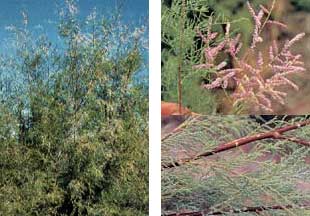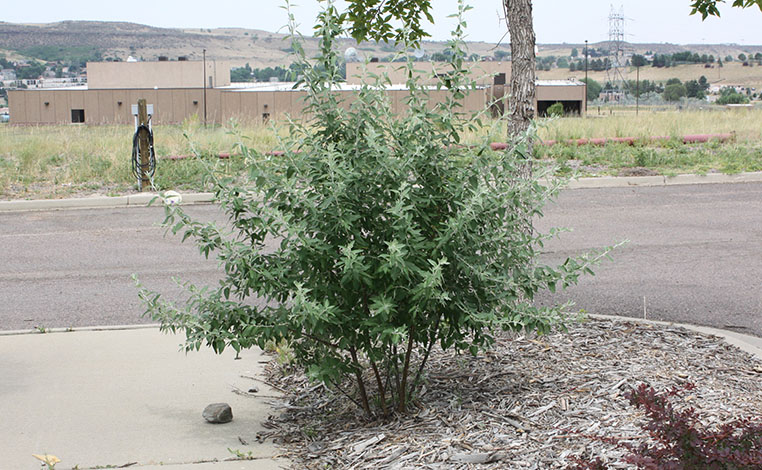Salt cedar
Tamarix ramosissima and T. chinensis.
Keys to Identification
- Saltcedar is a shrub or tree native to the Mediterranean, China and Central Asia. This plant is found infesting waterways throughout the west. These plants contain salt that they deposit onto the soil through their leaves. Other riparian species are unable to survive the salty conditions and Salt cedar can then become the only plant growing in an area. Some reports show that one acre of Saltcedar can use 7.7 acre feet of water a year (2.8 million gallons).
- Although this plant has been sold as an ornamental in the past, it is no longer allowed to be sold in Colorado.
This information courtesy of the Colorado Natural Areas Program
Family
Tamarisk(Tamaricaceae)
Other Names
Tamarisk, salt cedar
USDA Code
TARA, TAPA4
Legal Status
Colorado Noxious Weed List B
Identification
Lifecycle
Perennial
Growth form
Deciduous, loosely branched shrubs or small trees.
Flower
Flowers are whitish or pinkish and borne on slender racemes up to 2 1/2 in long on the current year’s branches and are grouped together in terminal panicles. Petals are usually retained on the fruit.
Seeds/Fruit
The seeds are borne in a lance-ovoid capsule.
Leaves
Leaves are minute, appressed scaly leaves, alternately arranged.
Stems
Branchlets are slender; plants may reach heights of 15 ft or more.
Roots
The primary root can grow to a depth of up to 95 ft or more (Baum 1978). Plants can develop spreading horizontal roots after reaching the water table. These can spread up to 165 ft and are capable of producing adventitious buds (DiTomaso 1996).
Seedling
Slender, reddish single stem.
Similar Species
Exotics
None known.
Natives
None known.
Impacts
Ecological
Salt cedar is an aggressive, woody invasive plant species that has become established over as much as a million acres of the western United States (Carpenter 1998). Salt cedar crowds out native stands of riparian and wetland vegetation. It increases the salinity of surface soil rendering the soil inhospitable to native plant species. Salt cedar provides generally lower wildlife habitat value than native vegetation. Saltcedar widens floodplains by clogging stream channels and increases sediment deposition due to the abundance of salt cedar stems in dense stands.
Habitat and Distribution
General requirements
Salt cedar grows well on moist sandy, sandy loam, loamy, and clayey soil textures (FEIS 1998). Salt cedar is tolerant of highly saline habitats, and it concentrates salts in its leaves. Over time, as leaf litter accumulates under saltcedar plants, the surface soil can become highly saline, thus impeding future colonization by many native plant species. Salt cedar is not tolerant of shading. Shaded plants have altered leaf morphology and reduced reproduction (FEIS 1998). Salt cedar commonly occurs along floodplains, riverbanks, stream courses, saltflats, marshes, and irrigation ditches in arid regions of the Southwest and the Southern Great Plains (FEIS 1998).
Distribution
In Colorado, salt cedar is most commonly found between 3,400 to 7,000 ft (FEIS 1998), but can be found up to 8,000 ft (A. Green, pers. comm.). It is widespread in riparian areas throughout the western United States.
Historical
Introduced to North America for use as ornamental, windbreak, and erosion control trees.
Biology/Ecology
Life cycle
Salt cedar generally flowers in its third year of growth or later, but may flower during the first year (FEIS 1998). Buds generally break dormancy in February or March. The flowers are most abundant between April and August, but may be found any time of the year in desert areas. Salt cedar flowered continuously under favorable environmental conditions but the flowers required insect pollination to set seed. Seedlings grow slowly and require saturated soils throughout the first 2-4 weeks of growth (FEIS 1998). Ideal conditions for first-year survival are saturated soil during the first few weeks of life, a high water table, and open sunny ground with little competition from other plants.
Mode of reproduction
Reproduces by seeds as well as vegetatively. Sprouts from the root crown and rhizomes, and adventitious roots sprout from submerged or buried stems (FEIS 1998). This allows salt cedar to produce new plants vegetatively following floods from stems torn from the parent plants and buried by sediment.
Seed production
A mature salt cedar plant can produce 600,000 minute seeds annually (FEIS 1998).
Seed bank
Seeds are viable for up to 45 days under ideal conditions during summer, and can complete germination within 24 hours following contract with water (Carpenter 1998). Salt cedar seeds had no dormancy or after-ripening requirements.
Dispersal
The seeds are readily dispersed by wind and water.
References
Baum, B. 1967. Introduced and naturalized tamarisks in the United States and Canada (Tamaricaceae). Baileya 15:19-25.
Carpenter, A.T. 1998. Element Stewardship Abstract for Tamarisk. The Nature Conservancy Wildland Weed Database. Internet 2/9/99.
DiTomaso, J.M. 1996. Identification, biology, and ecology of salt cedar. Pp. 4-8 In: Proceedings of the saltcedar management workshop. June 12, 1996 Rancho Mirage, CA.
FEIS – Fire Effects Information System [Online] (1996, September). Prescribed Fire and Fire Effects Research Work Unit, Rocky Mountain Research Station (producer), US Forest Service. www.fs.fed.us/database/feis/ [1998,March 12]
Frasier, G.W., and T.N. Johnsen Jr. 1991. Saltcedar (Tamarisk) Classification, Distribution, Ecology and Control. Noxious Range Weeds. Boulder: Westview Press. pp. 3777-3784
Whitson, T.D.(ed.), L.C. Burrill, S.A. Dewey, D.W. Cudney, B.E. Nelson, R.D. Lee, R. Parker. 1996. Salt cedar. Weeds of the West.
Western Society of Weed Science, in cooperation with the Western United States Land Grant Universities Cooperative Extension Services, Newark CA. pg. 584.


